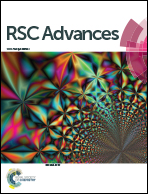Three-dimensional plasmonic hydrogel architecture: facile synthesis and its macroscale effective space†
Abstract
A three dimensional (3D) hydrogel SERS substrate decorated with Ag nanoparticles (NPs) was fabricated by in situ reduction of Ag+ ions in a polyvinyl alcohol (PVA) network. This offered tuneable, easily-operational and extremely homogeneous SERS 3D substrates composed of uniformly distributed Ag NPs. Due to its good light penetration, a macro effective space with a depth of more than one hundred micrometres in this translucent 3D network was confirmed by slice observation and depth scanning techniques. Such macro effective space may come from harvesting plasmonic effects between active Ag NP couplings in all of the x, y, and z directions, resulting in a great average field within the whole substrate region. Due to its large effective depth, the 3D hydrogel is more sensitive and more tolerant toward an out-of-focus laser position in trace detection of the sample. The free-standing and flexible structure is also employed in environmental analysis by using a portable Raman instrument, showing its promising potential for real applications.


 Please wait while we load your content...
Please wait while we load your content...